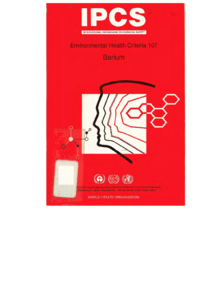Barium

World Health Organization ; UN. Environment Programme
WHO - Geneva
1990
148 p.
Environmental Health Criteria
107
Chemicals
English
Bibliogr.
92-4-157107-1
Barium is one of the alkaline earth metals, having a relative atomic mass of 137.34 and an atomic number of 56. It has seven naturally occurring stable isotopes, of which 138Ba is the most abundant. Barium is a yellowish-white soft metal that is strongly electropositive. It combines with ammonia, water, oxygen, hydrogen, halogens, and sulfur, energy being released by these reactions. It also reacts strongly with metals to form metal alloys. In nature barium occurs only in a combined state, the principal mineral forms being barite (barium sulfate) and witherite (barium carbonate). Barium is also present in small quantities in igneous rocks and in feldspar and micas. It may be found as a natural component of fossil fuel and is present in air, water, and soil.
Digital
The ETUI is co-funded by the European Union. Views and opinions expressed are however those of the author(s) only and do not necessarily reflect those of the European Union or the ETUI.